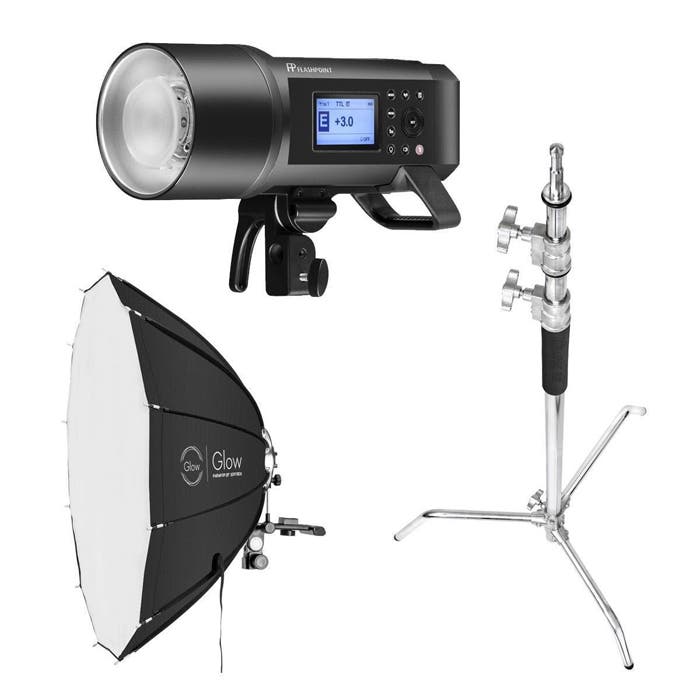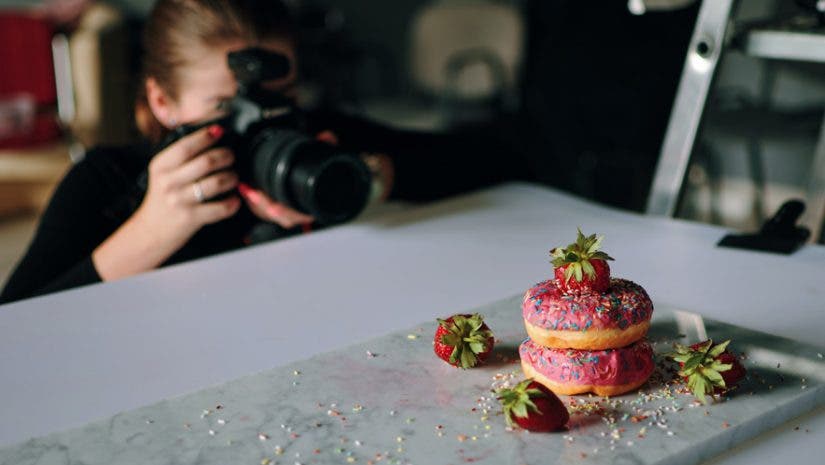Capturing mouthwatering food photos starts with the right camera, but you’ll need a solid food-photography kit to really make those images stand out. That’s where additional food photography equipment and accessories come into play.
From lighting to tripods and color-correction tools to lenses, here are six of the most important food-photography accessories to take your images to the next level — and cultivate hungry fans and followers in the process!
Achieving Professional Food Photography Photos
Photographers swear by several things when taking pictures of food: natural light, shot variety (overhead, from the side, and action shots like cooking), a clean, clutter-free scene, and, gear-wise, a camera with a prime lens. The former, natural light, is arguably the most important first step. If you’re photographing in a dim restaurant, use a soft, diffused light to create a natural look—although it’s ideal to photograph food and meals by a window when possible.
Must-Have Food Photography Equipment
A basic food photography equipment kit isn’t too extensive; it only takes a few pieces of gear to make your pictures of food shine. The necessary gadgets? A camera, prime lens (such as a 35mm or 55mm), a tripod with a tripod arm extender for overhead shots, a lighting kit, and, depending on the look and feel of the shoot, an aesthetically pleasing backdrop or faux countertop, such as a marble slab.

1. Prime lens
Prime lenses deliver crisp, sharp, and realistic photos that make dishes and desserts virtually jump off the screen or page. That’s why any serious food photographer needs one. Typically a 50mm focal length (a nifty fifty) will do the trick, although it’s always a good idea to have a wider angle for scene-setting shots or photographing in tighter spaces.
Primes also have a wider aperture, which means they’ll work pristinely in low-lit situations. Some of the most popular food-photography prime lenses include:
- Sony FE 50mm f/1.8
- Canon EF 50mm f/1.8
- Nikon NIKKOR Z 50mm f/1.2
- Fujifilm Fujinon XF 50mm f/1.0
- Panasonic 50mm f/1.4 LUMIX S-Pro

2. Tripod
Whether you’re filming video content or capturing action shots of recipes in the making, you’ll need a solid tripod. Tripod options run the gamut, and choosing the right tripod for you might seem challenging. But one of the most versatile options is the Manfrotto Element MII Aluminum Tripod. You can take this compact-yet-durable tripod with you wherever you’re cooking, be it at home or on the road. This tripod offers top-notch stability, with versatile angle options thanks to two independent leg angles.

3. Tripod arm extender
To capture those mid-stir or dining shots from above, you’ll need a reliable tripod arm extension like Photek’s The eXtender. This 32-inch telescopic tripod arm attaches to most tripods, letting you shoot from overhead without asking your family or friends for help. The eXtender has a universal clamping device that syncs with just about every tripod, not to mention a counter-weighted aluminum telescoping extension and a quick-release ball head for easy camera mounting.

4. Lighting kit
A strobe light is your best bet for professional-quality food photos, and the Flashpoint XPLOR 600PRO is among the best of them. This handy kit is about as close to natural light as it gets; it promises stable color output, versatility across scenes, and dazzling imagery without add-ons. The built-in R2 Radio System connects with Canon, Sony, Nikon, Fujiflim, and Olympus/ Panasonic for remote light controlling. It’s a must-have for shoots when time is of the essence, whether it’s melting ice cream or capturing steaming veggies.

5. Color correction card
Few things make food photos less appetizing than unnatural yellow hues; that’s why color-temperature hacks like the DGK Color Tools Reference Cards are a must-have for food photographers. These affordable cards work with JPEG, RAW, film, or digital formats. Simply set the white balance with the cards manually and watch as your food shots deliciously come to life.

6. Backdrops
Countertops, marble pastry boards, and even art paper work well for food-photography backdrops, but one of the best ways to capture a clean, polished photo is the Flashpoint Shooting Table with Plexi Glass. This budget-friendly table offers a glossy white background with a 24 by 40-inch Plexiglass sheet that can be lit to eliminate shadows, mimic spotlighting, or creating drop-shadow effects. The Flashpoint table is ideal for commercial, food, and product photographers.
Alternatively, you can also use a background board — like the varieties available from V-Flat World — to get an even background.

7. Computers & Accessories
Sure, you have your food photography equipment, but what kind of computer accessories do you need to perfect those culinary shots? Here’s where to start:
Laptops
If you want to level up your food photography, you’re going to need a powerful laptop to create a seamless photo editing and live-review experience. Some of the best options include the Dell Inspiron 15 and, for Mac users, the Apple MacBook Pro 16-inch. Both of these laptops come with stunning, sharp displays with ample power for photo processing.
Hard Drives
Photographers swear by using external hard drives, and for good reason: You can tote them around with you on travels, and it keeps those important images protected. Two of the best hard drives for photographers are the LaCie Rugged USB-C 3.0 hard drive and the SanDisk Extreme PRO hard drive.
Tethering Gear
Tethering is a great way to monitor your images in real time, via your laptop. That way you can finetune and adjust in the moment instead of having to reset the entire scene. Tether Tools offers one of the best ways to get started with this process via its TetherGuard Tethering Support Kit.

8. Photo editing software
One of the most important elements of the food-photography process? Photo-editing technology. Photo editing software such as Adobe Lightroom lets you fine-tune your pictures of food exactly as you’ve envisioned. You can mask the lead dish and lighten or up saturation to make it stand out. Alternatively with Adobe Lightroom, you can easily use presets to edit a series of photos from the same restaurant (and therefore with the same setting) without compromising on quality. Lightroom is by far one of the most popular options for editing software—not just for food photography, but for the entire photography industry.

9. Props
While the main focus of food photography is, of course, the food, there are some food-photography props you can use to add interest to your images. Try a marble-slab backdrop if you want a clean, bright aesthetic. You can also add to the scene with vintage dishes, silverware, or table décor like candlesticks. If you’re going for a fun, summery look, try colorful straws. Clean, wrinkle-free linens can help set the scene as well. To find what works for you, research similar photo examples via Pinterest or magazines, and see how they’ve set the scene, and adapt your set from there.
Craving more food-photography inspiration? Don’t miss our interview with Jessica Hirsch of famed Instagram account Cheat Day Eats!






